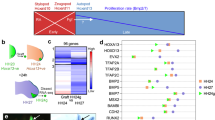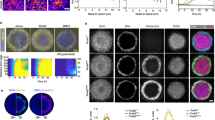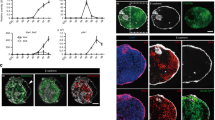Abstract
RETINOIC acid is a putative morphogen in limb formation in the chick and other vertebrates1-5. In chick limb formation, it is thought that retinoic acid is released from the zone of polarizing activity (ZPA) and the concentration gradient of retinoic acid formed from the posterior to the anterior provides positional cues for digit formation1-4,6. Implantation of a bead containing retinoic acid at the anterior margin of the limb bud induces a mirror-image symmetrical duplication of the digit pattern similar to that observed when the ZPA is grafted into the anterior margin of the host limb bud7,8. Also, the level of endogenous retinoic acid (25 nM on average) is higher in the posterior one third of the limb bud1,6. We found that when the bead containing either retinoic acid or an analogue but not the ZPA, was implanted in the anterior margin of the chick limb bud, expression of the retinoic acid receptor type-β gene was induced around the bead within 4 h. These results indicate that exogenous retinoic acid is not identical with the ZPA morphogen. As the anterior tissue exposed to retinoic acid has polarizing activity9, we conclude that the primary function of exogenous retinoic acid is to induce polarizing activity in the limb bud.
This is a preview of subscription content, access via your institution
Access options
Subscribe to this journal
Receive 51 print issues and online access
$199.00 per year
only $3.90 per issue
Buy this article
- Purchase on Springer Link
- Instant access to full article PDF
Prices may be subject to local taxes which are calculated during checkout
Similar content being viewed by others
References
Eichele, G. Trends Genet. 5, 246–251 (1989).
Brockes, J. P. Neuron 2, 1285–1294 (1989).
Wolpert, L. Development 107 (suppl.), 3–12 (1989).
Summerbell, D. & Maden, M. Trends. Neurosci. 13, 142–147 (1990).
Ide, H., Dev. Growth Different. 32, 1–8 (1990).
Thaller, C. & Eichele, G., Nature 327, 625–628 (1987).
Tickle, C., Alberts, B. M., Lee, J. & Wolpert, L. Nature 296, 564–565 (1982).
Summerbell, D., J. Embryol. exp. Morph. 78, 269–289 (1983).
Summerbell, D. & Harvey, F. Prog. Clin. Biol. Res. 110, 109–118 (1983).
Zelent, A., Krust, A., Petkovich, M., Kastner, P. & Chambon, P. Nature 339, 714–717 (1989).
de Thé, H., Marchio, A., Tiollais, P. & Dejean, A. Nature 330, 667–670 (1987).
Hamburger, V. & Hamilton, H. J. Morph. 88, 49–92 (1951).
de Thé, H., Marchio, A., Tiollais, P. & Dejean, A. EMBO J. 8, 429–433 (1989).
de Thé, H., Vivanco-Ruiz, M., Tiollais, P., Stunnenberg, H. & Dejean, A. Nature 343, 177–180 (1990).
Sucov, H. M., Murakami, K. K. & Evans, R. M. Proc. natn. Acad. Sci. U.S.A. 87, 5392–5396 (1990).
Eichele, G. & Thaller, C. J. Cell Biol. 105, 1917–1923 (1987).
Tickle, C., Lee, J. & Eichele, G. Devl. Biol. 109, 82–95 (1985).
Thaller, C. & Eichele, G. Nature 345, 815–819 (1990).
Noji, S. et al. FEBS Lett. 259, 86–90 (1989).
Dollé, P. et al. Nature 342, 702–705 (1989).
Oliver, G., Robertis, E. M., Wolpert, L. & Tickle, C. EMBO J. 9, 3093–3099 (1990).
Eichele, G., Tickle, C. & Alberts, B. M. Analyt. Biochem. 142, 542–555 (1984).
Tickle, C. Nature 289, 295–298 (1981).
Sanger, F., Nicklen, S., & Coulson, A. R. Proc. natn. Acad. Sci. U.S.A. 74, 5463–5468 (1977).
Noji, S. et al. Acta Histochem. Cytochem. 23, 353–366 (1990).
Noji, S., Yamaai, T., Koyama, E., Nohno, T. & Taniguchi, S. FEBS Lett. 257, 93–96 (1989).
Osumi-Yamashita, N. et al. FEBS Lett. 264, 71–74 (1990).
Tamura, K., Ohsugi, K. & Ide, H., Cell Dif. Dev. 32, 17–26 (1990).
Summerbell, D. J. Embryol. exp. Morph. 32, 227–237 (1974).
Author information
Authors and Affiliations
Rights and permissions
About this article
Cite this article
Noji, S., Nohno, T., Koyama, E. et al. Retinoic acid induces polarizing activity but is unlikely to be a morphogen in the chick limb bud. Nature 350, 83–86 (1991). https://doi.org/10.1038/350083a0
Received:
Accepted:
Issue Date:
DOI: https://doi.org/10.1038/350083a0
This article is cited by
-
Retinoic acid in development and regeneration
Journal of Biosciences (1996)
-
Retinoic acid and retinoic acid receptors in development
Molecular Neurobiology (1995)
-
The chicken retinoid-X-receptor-? (RXR-?) gene and its expression in the developing limb
Roux's Archives of Developmental Biology (1995)
-
Stable, position-related responses to retinoic acid by chick limb-bud mesenchymal cells in serum-free cultures
In Vitro Cellular & Developmental Biology - Animal (1994)
Comments
By submitting a comment you agree to abide by our Terms and Community Guidelines. If you find something abusive or that does not comply with our terms or guidelines please flag it as inappropriate.



